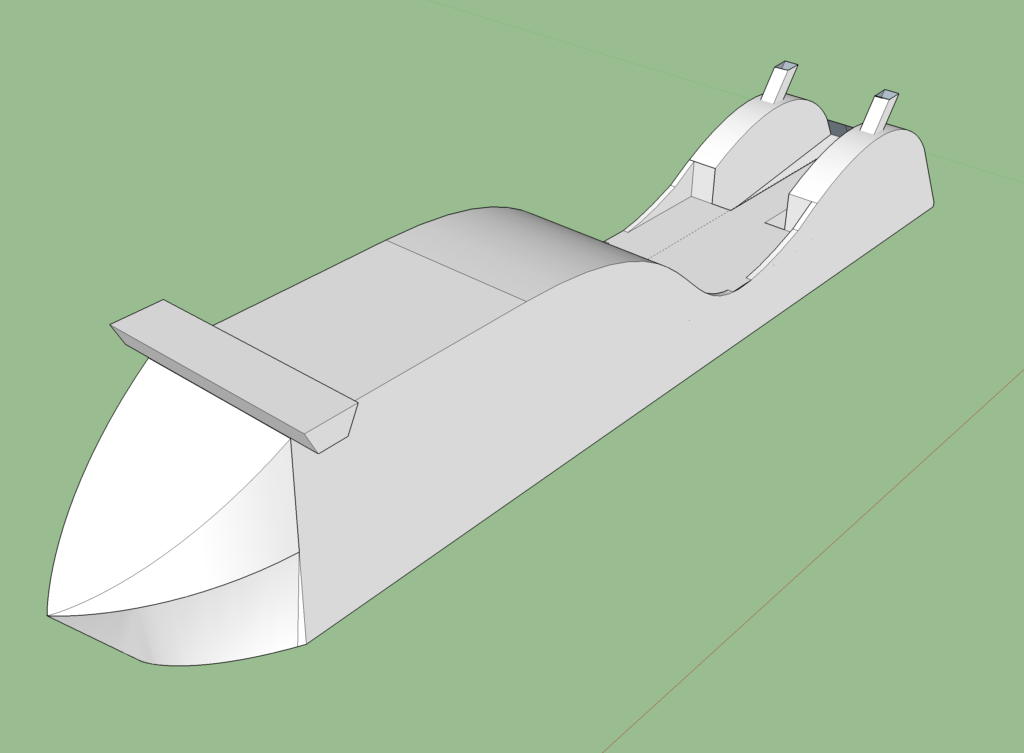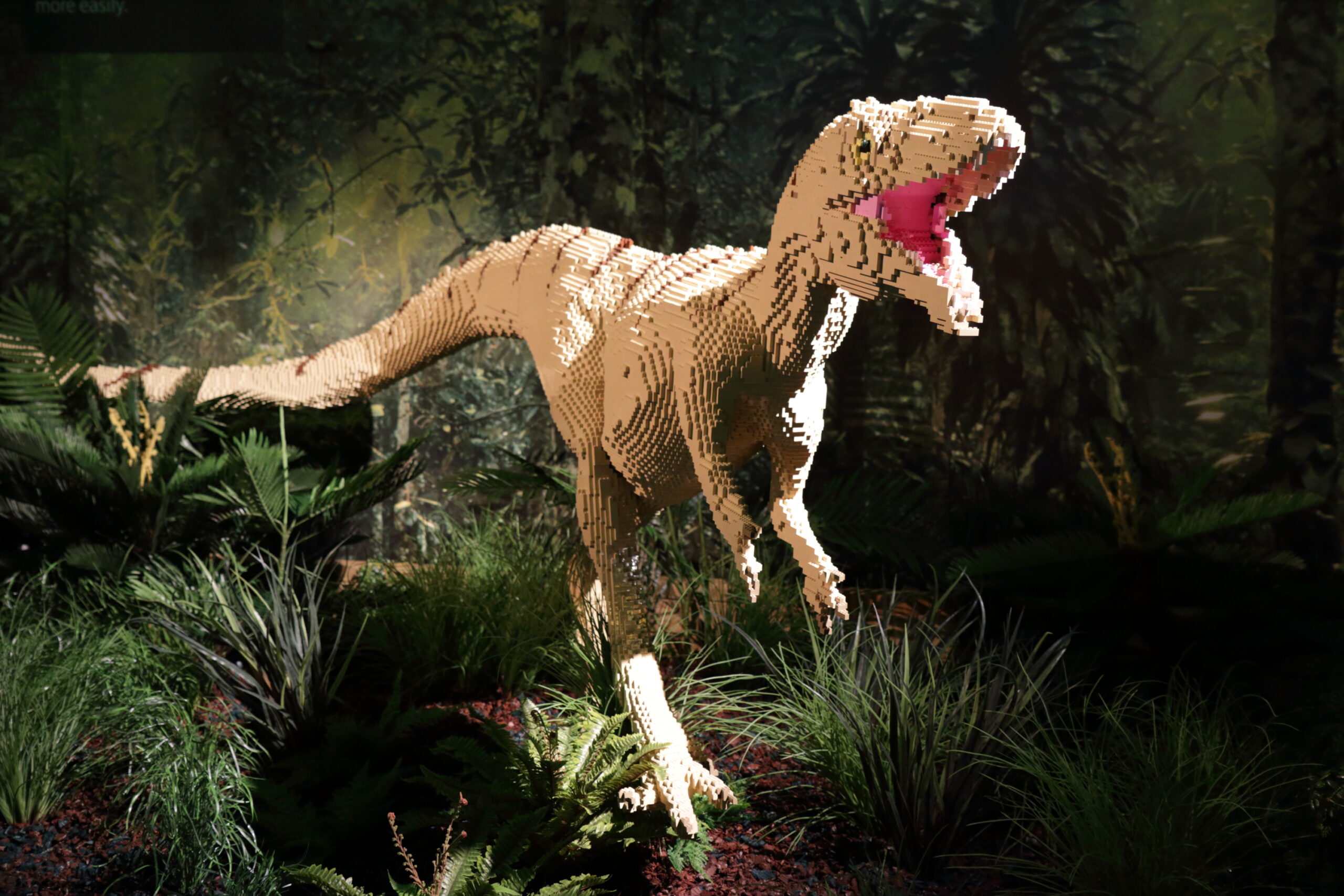
Warren Elsmore
is a freelance artist and author, who creates unique, one-off, LEGO models for individuals and corporate companies. Based in Edinburgh in the UK he works worldwide for organisations including IBM, LEGO, Historic Scotland, DFDS, WPP, Visit Denmark and many more. Warren has been a LEGO fan since the age of 4 and has had ‘the best job in the world’ since 2012. Now 38, he is world renown for his creations.
We chatted with Warren to learn more about how he uses SketchUp as an artist in LEGO bricks.
Hi Warren - Can you introduce yourself and the team to the SketchUp community?
I usually get introduced is as the ‘LEGO man’, but my real name is Warren Elsmore. I’m an artist/model maker/author/events co-ordinator working entirely in LEGO bricks. I run a very small team but we work worldwide – either designing and building models for clients, touring LEGO exhibitions or facilitating events and activations using LEGO bricks. Basically, if you have a wacky idea that you think might work with in LEGO bricks – we’re the people to make it happen.
Over the last 10 years, we’ve broken two Guinness world records for our LEGO builds as well as releasing 12 books on LEGO models. My books range from topics as diverse as Dinosaurs to Cars, or Martin Luther King to the Statue of Liberty. Five of our books have been turned into touring LEGO exhibitions which travel the world attracting thousands of visitors wherever they go. As LEGO models are something of a niche product – my team are heavily involved in the logistics of transport and installation too. Something that comes in handy when we’re asked to create a huge commissioned piece and deliver it! It’s not uncommon to see us at Edinburgh airport with huge amounts of LEGO bricks, flying off to work with a customer or be on their trade stand at an exhibition.


Lego is such an iconic and beloved brand – talk us through your love for the little plastic bricks! How did you end up as an artist in LEGO?
I’m told that my love for LEGO started young – my parents can’t actually remember when I got my first LEGO set. What I can remember is always being interested in it. Before the internet came into its’ own – I used to pick up a LEGO catalog from my local toy shop and spend hours looking through it. I would decide which sets I wanted the most, which I would ask Santa for and which I might ask my aunts and uncles to buy me for my birthday. I was lucky at least some of the time!
Like most people my age (mid 40’s now), when I got to my teenage years, LEGO took a bit of a back seat. It certainly wasn’t cool to still be playing with LEGO at that time. So, my attention waned until I was gifted a large LEGO set for my 20th birthday by a girlfriend. Little did she know what she would set in motion! There was a growing adult fan scene at that time, so I joined the UK club which at the time only numbered a hundred of so.
Fast forwarding to 2012, I was lucky to be involved in two projects at the same time. Firstly, I’d recently finished a LEGO model of St Pancras station in London which used around 180,000 pieces. An editor had seen the model and wondered if it was possible to create a book with “maybe 20 such creations”. Having spent 2 years on the model as a hobby, we compromised on a few larger models and lots of small, buildable, models. These would have instructions that I would write for people to follow.
At the same time, I had been talking to LEGO about celebrating the London Olympics in 2012. There is somewhat of a tradition for the LEGO fans in each host country to create something special to celebrate the Olympics. In the end, working with the Danish tourist board, I created a model of the London Olympic park which I delivered to their Olympic hospitality area. This, of course, created a huge amount of press interest around the world. As I was already very busy writing the first book, it was becoming difficult to balance an IT consultancy career with LEGO building. Something had to go and 2012 was the best opportunity I’d ever get to be making LEGO models for a living! Thankfully, it seems to have paid off!
How does SketchUp help with your design process?
SketchUp is important to our design process as it enables us to turn our ideas into something we can show to a customer and they can understand. Almost everything we do is bespoke in some way or another so there aren’t any existing images to show someone or get a message across.
As an example, lots of our LEGO models are built into display cases that we produce specifically for them. As LEGO can be quite a fragile medium, if a model is going to go on tour, we will usually design it to be built into its’ case for rigidity. We do have a specific piece of CAD software for modelling LEGO bricks – but I will import the final model from that into SketchUp to start designing the case. We have a fantastic carpenter who I can then send a SketchUp model to, in order for him to work out how to build it in real life! Very large models will also have a steel frame inside that we design. LEGO works to very tight tolerances, so it’s vital that we can create a steel framework that will work to support the model properly. Working with structural engineers, we design these in SketchUp as it allows us to quickly see how it will interact with the case and model.
Our touring exhibitions use SketchUp every single time we go to a venue. We now have all of our exhibitions drawn in SketchUp so that we can create a virtual version of the installation first. This means that we can install a 400sqm exhibition in only a couple of days. As well as helping us sell the idea to a venue – it also means that the installation is as quick and easy as possible. Essential when I have to send staff to do the installation, often a long way away!
We also use SketchUp models as the starting design for some LEGO models themselves. When we’re working with a very complex shape – or a shape that has to be extremely exact, we’ll often design the LEGO build from a 3D model. A good example of this are models that we produced called the ‘Kelpies’. These are enormous works of art produced by a local sculptor – 30 meters high! As they are extremely unique in their construction we actually found that there was no 3D model available of them at all. We ended up working with the wind tunnel models which had been created by hand. They were 3D scanned, then imported into SketchUp to tidy up and simplify the model. Once we were happy with it, we used some software that we’ve had written in order to turn the design into LEGO bricks. This sort of build would be fantastically time consuming to do ‘by eye’, so SketchUp saves us hundreds of hours.

Whilst to many, LEGO bricks are ‘just a toy’, to an ever growing army of fans they provide a challenging and enjoyable modelling medium. These fans call themselves ‘AFOLs’, or Adult Fans of LEGO. You’ve written entire books on the subject. Can you talk us through a few of them?
Most of my books are around a specific topic, ‘Brick City’, ‘Brick Wonders’, ‘Brick Dinos’ etc. They all share some similarities though. Around half of the models shown in the book will simply be photographic. Coffee Table images, so to speak. The other half of the models will be ‘buildable’. That means that I’ve written instructions for each of the models and you can build them at home.
There is quite a difference between the two types of models. Creating a model with instructions places quite a lot of restrictions on what I can do. Obviously, any model that we produce with LEGO bricks will ‘work’ properly and the bricks will stay together. However, there are lots of techniques that are either too delicate to ask someone else to replicate – or too complex to do given the number of pages allowed! The buildable models are great fun, but it’s the other models where we can really go to town with our model making.
Do you ever have anything like a ‘typical’ work day?
Rarely! I have found though, that it often helps me to have a ‘work’ day, rather than a ‘build’ day.
If I’ve got a large or complex build to do, I will often go into the studio and not even open my laptop. We all have two desks in the studio – one for desk work and one for building. It can really help my creativity to separate the two sometimes. If the project is more defined though, those lines will often blur. Some of our best projects have been almost 50/50 design and build. Any large scale work that we do almost always exists in a digital form first, so a laptop goes hand in hand with LEGO bricks.

What kind of projects interest or excite you the most?
Having spent nearly 20 years working in IT, it’s still the most complex projects that excite me, or ones that combine multiple medias. We have models with inbuilt programmable lighting or some with digital advertising screens and blending the two together seamlessly really interests me.
I’m also a fan of problem solving in general. Sometimes we’ve booked our exhibitions into very small spaces – so advance planning is essential. I’ve been known to spend an entire day working out how to organise exhibits in a single room. It’s always worth it though when we come to deliver the real thing. This has actually become essential in 2020. As well as all of our normal planning, we’ve had to take social distancing into account as well. Being able to show a venue a well thought out floor plan has helped us to minimise risk to both the public and staff when planning an exhibition.
Do you use any essential plugin or extensions with SketchUp to help with your work?
We don’t have any essential plugins or extensions yet – though I’ll often install one to help accomplish a specific task. As all our work changes, it’s hard to know what to expect! What is really essential for us is the 3D warehouse. Exhibition planning often involves really common items – such as IKEA furniture! So it’s really handy to be able to look into the warehouse and see if there is a quick model we can put into our plans for a client. Of course, what we deliver will certainly change before the show opens, but the speed of being able to turn around ideas often wins us business.
You’re based in beautiful Edinburgh; what are the benefits of purchasing SketchUp via local reseller, SEE-IT-3D?
I guess I’m lucky in that my IT experience has meant that I’m pretty quick to learn new software. We’ve not needed any real training to use Sketchup at all. However, it’s really great to know that support is there if we need it and SEE-IT-3D have always made sure that we’re kept up to date with software releases and features.

What’s been your proudest work so far/career highlight?
We’ve had a lot of highlights, but the one project that stands out for us was a collaboration with the Danish shipping company, DFDS. In 2016, they celebrated their 150th anniversary as a company and decided that they wanted a way for the whole company to celebrate. That included 9000 staff across the whole of Europe on and off shore!
Although DFDS had decided on a LEGO project of some sort (LEGO being a Danish company as well and building being well known as a family activity in Denmark), they weren’t exactly sure what – or how – the project should look like. After a long period of consultancy with myself, they decided to build the worlds’ largest LEGO ship. It would, of course, be a DFDS ferry, and they wanted to go as large as possible. We settled on 14 meters – about as long as we could build inside the back of one of their lorries. We showed them how we could construct the ferry as a ‘BIG build’. Each DFDS staff member would build 40 small bricks into one, BIG, brick. Their logistics expertise would then ship those bricks from all over Europe to our studio in Edinburgh. We’d build these ‘BIG bricks into their ship, 4 times larger than a ‘small’ prototype that we had designed from the Sketchup model. That small prototype being only 3.5m long!
DFDS created an original design for the ferry that they though would work well and passed it back to us. We then created a 3D model of this ship design in SketchUp showing them how it would look inside a lorry. I think it’s that visual that convinced their board we really were serious! Once we got the green light, 1.2 million bricks were ordered from LEGO, and we started to work on the design of both the LEGO model and the steel framework. As the DFDS staff would be constructing the large bricks for us – there was no option to glue them together. The ship also had to survive a planned 3 month trip around Europe by road and sea. These two constraints meant that we had to devise a special framework to hold the bricks in place no matter what. It is probably the only LEGO model ever to come with a manual that mentions torque settings!
After a lot of planning and testing, we could finally put everything into production. The Sketchup model we had used before had the steel framework added to it which meant we could send it to our fabricators. They could use the model (tagged with the different materials) to see where support was necessary and where they would need to be more precise. We could also work out where the trailer was likely to flex as it was moved around. Important, because LEGO doesn’t bend!
DFDS ran a company wide publicity scheme and all of their staff were involved in helping the build the bricks for the ship. We even got video messages back from ships’ bridges and a real DFDS flag as a gift! As quickly as the bricks arrived – we added them into the ship. In the end, it took a team of 6 people 16 days to assemble the BIG bricks into a really BIG ship. It was unveiled at their head offices in Copenhagen as the Guinness World Record ‘Largest LEGO Brick ship (supported)’. We even had a LEGO champagne bottle to christen her!
After her initial 3 month tour the ‘Jubilee Seaways’, as DFDS had christened her, went on to visit almost all of their offices right around Europe. My team helped take her into Trafalgar square (with a LEGO Christmas tree on board), as well as the European parliament, numerous ports – she even made it to Turkey! The project eventually went on to win a European marketing award for the programme that their communications department had delivered. The ship was eventually decommissioned in 2019, when the LEGO bricks she was made from were sold to LEGO fans in aid of charity.




